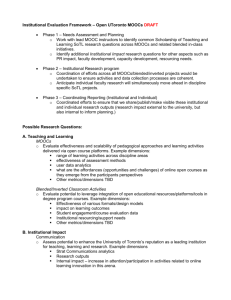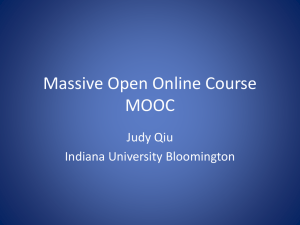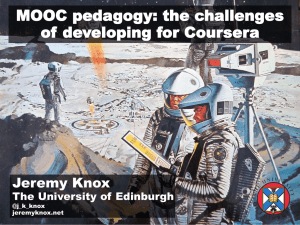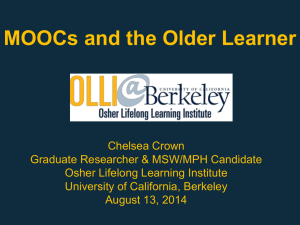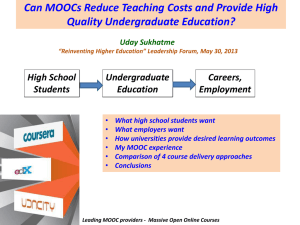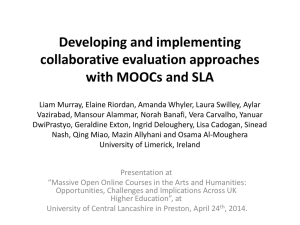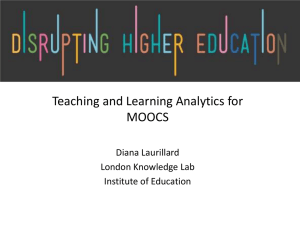MOOCs
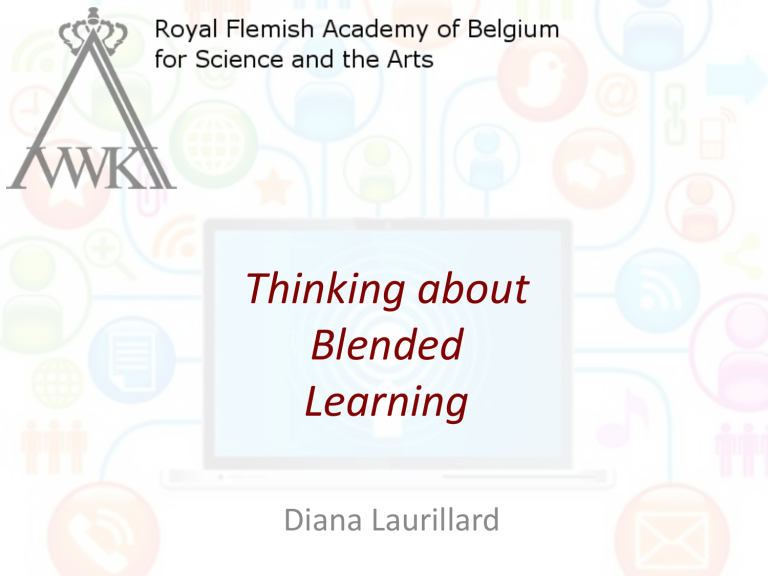
Thinking about
Blended
Learning
Diana Laurillard
The global demand for education
By 2025, the global demand for higher education will double to ~200m per year, mostly from emerging economies (NAFSA 2010)
1,600,000 new teaching posts needed for universal primary education by
2015.
3,300,000 new teachers by 2030 (UNESCO 2013)
Student loan debt in US is higher than CC debt so students will demand new models of teaching and learning
Can we use technology to reduce the current staff:student ratios of higher education and maintain quality?
The overall programme aim
From blended to open learning? Internet and
ICT in Flemish Higher Education:
- the purpose of which is the development of a systemic vision on the optimal exploitation of
ICT and internet for the new learning of the
21st century and to provide an alternative perspective aiming at formulating long term policy objectives.
10 Discussion items on Blended Learning
1. How will blended learning change HE on campus (BA, MA)?
2. Blended learning and the teacher
3. The evaluation, exams and assessment challenge
4. Open and distance learning - Lifelong learning
5. Blended learning and the institution
6. Inter institutional networking (national, European and global)
7. MOOCs
8. Implications for interaction with secondary / primary education
9. Role of government and official bodies
10. Potential for development cooperation
Blended, Online and Open Learning
Blended
Online
Blends online and f2f for campus students
Online only, anywhere
Dual mode Blended + equivalent online
Open Online with open entry (OU, MOOCs)
• Online learning offers opportunity of high fixed costs and low support costs to improve per-student cost
• Teaching costs must be carefully managed and planned
• Learning benefits must be designed and evaluated
• Technology use should start from problems, not solutions
HE problems and Technology solutions
•
•
•
•
•
•
•
• • Assessment does not motivate the
•
•
•
•
•
•
• Transition to HE is poor for many
Demand for quality HE cannot be
Employers dissatisfied with
Academics interested in research
Students have a digital life
Alumni need flexible continuing
Students lack motivation and
Potential technology solutions
Extend access to HE ICT resources and activities to schools
Use large-scale cascade online courses model to reach out
Use online collaboration to enable employers to influence curriculum
Link teaching to online research methods
Use online student collaboration for sharing digital learning ideas
Extend access to HE ICT resources and activities to alumni
Use tech to update assessment as automated and more challenging
Include digital tools for students to do inquiry, practice, discussion, collaboration, production
Models of online learning?
Problem/Issue Audience
Transition to HE Schools
Large classes Undergraduates
High demand Part-time students
High level skills Postgraduates
Pedagogy
Inquiry
Collaborative
All, pyramid + personal support
Workplace updates
Professionals
Alumni updates Alumni
MOOC, peer support
MOOC, low support
Lifelong learning
Open to all MOOC, peer support
Content Income
Repurposed
New
All, pyramid + personal support
New
All, high support New
Market driven
Research driven
Repurposed
Free
Fee + Govt
Fee +
Employer
Fee + Govt
Fee
Fee/Subscrip tion
Free
The MOOC as ‘large-scale’ pedagogy
Average student numbers per course - Edinburgh
Enrolled 51500
Accessed Week 1 20500
Engaged Week 1 15000
Week 5 asst's
Statement of Accomplishment
6000
5500
27%
0 10000 20000 30000 40000 50000 60000
Completed = 27% of ‘starters’
MOOCs @ Edinburgh 2013 – Report #1
The MOOC as ‘large-scale’ pedagogy
Average student numbers per course - UoL
Registered
Week 1
Week 2
Week 3
Week 4
Week 5
Week 6
SoA
0
53250
11377
9592
23367
17275
7730
6747
2211
10000 20000 30000 40000 50000 60000
9%
Completed = 9% of ‘starters’
MOOC Report 2013: University of London
The MOOC as undergraduate education
Not for undergraduates
PG degree
Degree
College
School
Less than high school
10%
17%
30%
40%
3%
0% 10% 20% 30% 40% 50%
70% have degrees
Enrolled students
MOOCs @ Edinburgh 2013 – Report #1
The MOOC as undergraduate education
Not for undergraduates
Enrolled students
Doctorate
Masters
Bachelors
Professional
A level
GCSE
Schooling
0%
4%
8%
11%
8%
3%
10% 20%
29%
35%
30% 40%
68% have degrees
MOOC Report 2013: University of London
The MOOC as undergraduate education
85% have degrees
MOOCs: Higher Education’s Digital Moment? 2013: UUK
The economics of teaching and learning in HE
Preparation of curriculum and resources
Adaptive systems: field trips, lab sessions, simulations, models
Expositions: lectures, study guides, sl ides, podcasts, videos
Formative assessment: feedback from peers, digital systems
Readings: books, papers, websites, pdfs
Collaborations: projects, workshops, role play simulations, wikis
Peer group discussion: seminars, discussion forums
Formative assessment: tutor feedback offline, feedback online
Tutored discussion: tutorials, small groups, discussion forums
Summative assessment: exams, essays, designs, performance
Fixed cost
Support for students learning Variable cost
Pedagogies for supporting large classes
Conceal answers to question
Ask for user-constructed input
Concealed MCQs
The (virtual) Keller Plan
The vicarious master class
Pyramid discussion groups
240 individual students produce
Student becomes tutor for credit
Pairs compare and produce joint response
60 groups of 4 compare and produce joint response and post as one of 10 responses...
6 groups of 40 students vote on best response
Teacher receives 6 responses to comment on
What it takes to teach with technology
The teaching workload is increasing in terms of
Planning for how students will learn in the mix of the physical, digital and social learning spaces designed for them
Curating and adapting existing content resources
Designing activities and resources for all types of active learning
Personalised and adaptive teaching that improve traditional methods
Providing flexibility in blended learning options
Guiding and nurturing large cohorts of students
Using learning technologies to improve scale AND outcomes
BUT:
Institutions and teachers do not typically plan for the teaching workload implied by these learning benefits nor for the need to collaborate to innovate with technology
??
The design cycle for teaching
Publish
Browse
Adopt
Build on others’ tested designs
Adapt
Develop
Make links to existing content resources
Test
Building teaching community knowledge
Redesign
Self review
The design cycle for science
What is the teaching design equivalent of the journal paper?
Publish
Browse
Adopt
Adapt
Develop
Test Review
Redesign
Building scientific knowledge
A tool for learning design: browsing
The Learning Designer: Adopt
(interpreting Tudor portraits)
Details of: learning context, topic, aims, outcomes, student numbers, duration
Details of the pedagogy: types of learning activity, group size, teacher presence, attached urls, duration, student guidance
Analysis of the learning experience calculated dynamically
The Learning Designer: Adapt
(experimental design for Psychology)
Note the designed time is much greater than the allotted time
Every section of the learning design can be edited, and new resources attached
Share to submit for review
Analysis of the learning experience adapts to your edits
The Learning Designer: Review
(Business planning for engineers)
Reviewer Feedback
Notes for additional comments
Reviews and comments could be student evaluations
Additional pane for
Reviewer to add comments according to criteria ‘Test of outcome? Alignment?
Feedback? Technology?
Teaching as a design cycle
Question:
What is the teaching design equivalent of the journal paper?
Publish
Answer:
A learning design that can be reviewed, adapted, improved, published, reused…
Test
Browse
Adopt
Adapt
Create
Review
Redesign
Building learning technology knowledge
Balancing the benefits and costs
It’s important to understand the link between the pedagogical benefits and teaching time costs of online learning – especially for the large-scale
What are the new digital pedagogies that will address the
1:25 student guidance conundrum? How to shift variable cost support to fixed cost support?
Can we develop a viable business model that will make HE more effective and affordable for undergraduates?
Analysing teacher workload
(the Course Resource Appraisal Model CRAM)
Run No. of students
Run 1
Run 2
Run 3
15
20
20
Learning experience
Teacher preparation time
Teaching support time
Details of: credit hours, cohort size, income, teacher costs, types of learning and teaching, online and f2f, time for prep and for support
Analysing teacher workload
(the Course Resource Appraisal Model CRAM)
Run 1 Run 2 Run 3
Students 15 20 20
Profit -£27k £4k £11k
Run 1 Run 2 Run 3
Students 15
Profit
30 60
-£27k £11k £38k
Analysing workload for a Basic MOOC
(the Course Resource Appraisal Model CRAM)
Run 1 Run 2 Run 3
Students 2000 2000 2000
Profit £21k £35k £35k
Assuming £20 (?) income for Signature Track
What if only 500 complete?
Run 1 Run 2 Run 3
Students 500 500 500
Profit -£9k £5k £5k
What does it mean for our online courses?
• The high visibility teaching in MOOCs will improve the presentation quality of UG and PG courses
• The need to design well-orchestrated groups and peer support activities will promote pedagogic innovation and better VLE functionality
• We can improve the variable costs of teaching support if we explore methods like
– pyramid collaboration groups: from many students to few outputs for tutors to inspect
– cascaded tutor: from one teacher to many tutors
– vicarious master class: from one small group to all
• They will only flourish if we demand, and get, improved pedagogic design functionalit y on VLE platforms
THEN perhaps UG/PG education can achieve high quality and reach that is more affordable
What does this mean for the future of blended learning?
• We need large student numbers to offset the high production costs of the ‘flipped classroom’ (and high visibility teaching)
• We must understand the variable costs of teaching support, as scaling up UG/PG teaching could be unmanageable
• Our current CPD model fits the MOOC pedagogy:
– Good presentation of latest thinking and ideas
– Peer discussion, debate, exchange, and challenge
– Certification of attendance
What might we do? A systemic approach
• Build a learning system: legitimise, incentivise, fund the lecturers to take innovative pedagogy as a part of their professionalism
• Engage the whole community in the current educational challenges What are they?
– and how technology can help.
• Fund the leading innovators (activist groups) to develop and share, and the leading followers to adopt then lead
• Fund further development of a pedagogically sound online platform – beyond current functionality – lecturers specify
• Launch a project on the modelling of high quality, large scale, flexible, affordable HE
Timeline and milestones to enable all departments/universities to integrate ICT in a sustainable way
Phase 4:
2017-19
Phase 3:
2016-17
Phase 2:
2015-16
Phase 1:
2014-15
